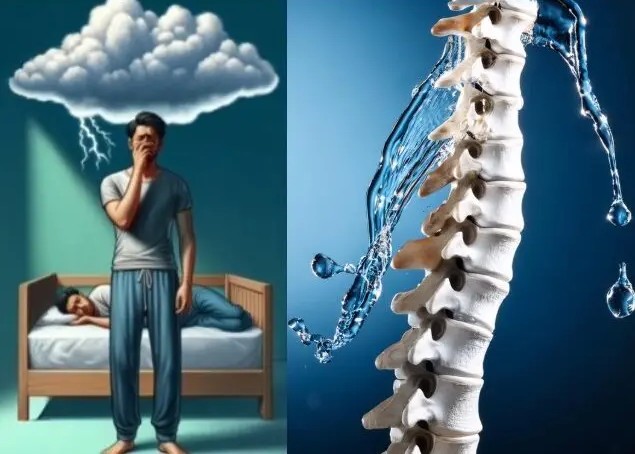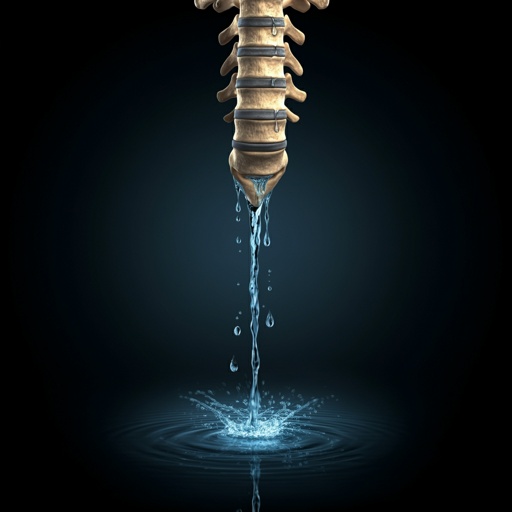Do you experience a pounding headache when you stand up? If so, you may be suffering from a low-pressure headache, or CSF leak headache, one of the most common causes of positional headache. Understanding the causes of these headaches and evaluating for other sources of positional headache is crucial for proper diagnosis and treatment. In this blog post, we will delve into the world of low-pressure headaches, exploring their symptoms, causes, mimics, diagnostic tests, and treatment options.
Positional Headache; Why Does My Head Hurt When I Stand Up?
Experiencing an orthostatic headache that intensifies upon standing can be perplexing and distressing. These symptoms of postural headaches could suggest several different causes, one of which is a low-pressure or positional headache, sometimes also called a spinal headache. The fundamental mechanics behind this type of headache are rooted in the dynamics of cerebrospinal fluid (CSF) within our central nervous system, which comprises the brain and spinal cord. Under normal circumstances, this fluid cushions and supports the brain, maintaining a harmonious balance of pressure inside and outside the brain tissues.
However, when the pressure of the CSF drops from a CSF leak—a condition technically referred to as intracranial hypotension—the brain lacks its usual support, leading to a “sagging” effect when standing. This sagging increases the strain on pain-sensitive structures within the skull, such as nerves, blood vessels, and the dural membrane around the brain, manifesting as a headache. The unique characteristic of these headaches is their positional nature; lying down often brings relief by allowing the CSF pressure to normalize across the brain and spinal cord, reducing the tension on these sensitive structures.
This drop in CSF pressure and the resultant headache can be triggered by several factors, including a leak in the dura mater—the tough outer membrane covering the brain and spinal cord—allowing CSF to escape. This leakage reduces the overall volume and pressure of CSF, exacerbating the headache when the individual stands up. Such leaks can occur spontaneously or as a result of medical procedures such as spinal tap, trauma, or underlying structural weaknesses in the dura mater for those with connective tissue diseases such as Ehlers Danlos Syndrome (EDS).
Understanding the nuances of why your head hurts when you stand up is crucial in navigating towards an accurate diagnosis and effective treatment plan. The mechanics behind low-pressure headaches illustrate the delicate balance maintained within our bodies and how disruptions to this balance can significantly impact our well-being. Recognizing the positional nature of these headaches as a key symptom can guide your doctor toward the root cause and the appropriate treatment.
What are the Symptoms of Low-Pressure Headaches and CSF Leak Headache
Navigating the symptoms of low-pressure headaches and understanding their association with CSF leaks is essential for anyone experiencing these debilitating conditions. These headaches typically manifest as a dull, throbbing pain that significantly intensifies when standing up or changing positions, or dull tension headaches. The nature is more often of a severe headache or head pain though. This characteristic is what distinguishes them as positional headaches, a direct result of the shifting pressures within the skull and spinal column.
One of the hallmark symptoms of low-pressure headaches is a noticeable relief when lying down. This is because the recumbent position helps to even out the distribution of cerebrospinal fluid, temporarily alleviating the pressure on the brain and spinal cord, and consequently reducing the pain. This positional relief is a key indicator that what you’re experiencing may very well be a low-pressure headache.
Beyond the unique positional pain, individuals may also experience a suite of other symptoms that can further hint at the presence of a CSF leak. Headache pain in the back of the head and neck stiffness are common symptoms, often described as a “rigid” sensation that makes turning the head uncomfortable. Nausea and vomiting are also frequent, adding to the overall discomfort and indicating the severity of the pressure imbalance. Light sensitivity, or photophobia, can make everyday environments feel overwhelmingly bright, signaling the brain’s heightened response to stimuli due to the lowered CSF pressure.
Further compounding these symptoms are those more directly tied to CSF leaks themselves, such as a metallic taste in the mouth, which can be peculiar and disconcerting. Changes in hearing, including muffled sounds or a ringing in the ears, suggest the leak’s impact on the ear’s inner workings. Visual disturbances, too, may present as blurriness or double vision, adding to the complexity of symptoms that individuals with low-pressure headaches may report.
It’s crucial to be vigilant about these symptoms, particularly if they persist or escalate. Each sign provides valuable clues about the nature of the headache and the potential involvement of a CSF leak. Understanding and recognizing these symptoms not only aids in seeking timely medical attention but also supports a more accurate diagnosis and the initiation of a targeted treatment strategy with your healthcare provider.
What Causes Low-Pressure Headaches? Unveiling the Culprits of Intracranial Hypotension
The genesis of low-pressure headaches is as complex as it is varied, embedding itself in the intricate interplay of our body’s internal pressures and the resilience of its structures. Intracranial hypotension, the technical term for decreased pressure in the space surrounding the brain and spinal cord, underpins the main culprit of these symptoms. This condition can emerge from a myriad of sources.
The primary trigger is a breach in the dura mater, the thick fibrous membrane encasing the brain and spinal cord, leading to cerebrospinal fluid (CSF) leaks. This efflux of CSF results in a discernible drop in the cranial and spinal pressures, giving rise to the characteristic headache that intensifies upon standing. Such leaks may spring from spontaneous events, where no clear precipitating factor can be identified, or follow traumatic injuries or surgical interventions, including lumbar punctures or spinal taps. These procedures, though critical for diagnostic or therapeutic purposes, bear the risk of puncturing the dura mater, inadvertently instigating a leak.
In addition to these acquired causes, risk factors in certain individuals may predispose them to low-pressure headaches due to underlying connective tissue disorders such as Ehlers Danlos Syndrome (EDS). These conditions weaken the dura mater, rendering it more susceptible to tears and, subsequently, CSF leaks. The inherent fragility of the dura in these patients sets the stage for spontaneous intracranial hypotension, complicating the diagnostic and treatment landscape. Some patients can develop a CSF leak as a result of idiopathic intracranial hypertension (IIH or pseudotumor cerebri). This is when the CSF pressure can get so high that it causes a leak to spring somewhere through the sinus cavities or along the spine.
Understanding the multifaceted origins of low-pressure headaches underscores the importance of a tailored approach to each case. Given the potential for a broad spectrum of underlying causes, from mechanical disruptions following medical procedures to inherent vulnerabilities in the body’s connective tissues, pinpointing the exact trigger is pivotal. This understanding not only illuminates the pathophysiology behind the patient’s symptoms but also directs the clinician towards the most appropriate and effective interventions, as well as future preventive considerations.
What are the Tests for Low-Pressure Headache?
Diagnosing a low-pressure headache entails a meticulous approach that combines a comprehensive patient medical history with advanced diagnostic techniques. The initial step in this journey is a detailed conversation, where your doctor gathers information on the headache’s characteristics, triggers, and alleviating factors, especially the notable improvement when lying down and worsening when upright.
Following this, a physical and neurological examination plays a pivotal role in helping to exclude other potential mimics of a CSF leak presenting as a positional headache. Some of these possible mimics from a different type of underlying cause could include a brain tumor, sinus infection, meningitis, Chiari malformation, cervicogenic headaches, or occipital neuralgia.
However, the cornerstone of diagnosing low-pressure headaches and excluding more sinister mimics such as a brain tumor lies in the realm of imaging studies. Magnetic Resonance Imaging (MRI) of the brain with contrast, sometimes complemented by MR venography (MRV) and MR angiography (MRA), is the most useful initial test. These scans can reveal tell-tale signs of intracranial hypotension, such as pachymeningeal enhancement, which indicates a widespread thickening and enhancement (bright white coloration) of the dura mater, or sagging of the brain structures. These are both hallmark indicators of reduced CSF pressure, but there are other findings that we also look for. The addition of IV contrast to the brain MRI is required to pick up this enhancement of the meninges, caused by inflammation from the sagging of brain structures. This will not be been without contrast, so it is important to discuss adding contrast with your doctor. A CT scan is not a helpful test for evaluation of spinal headaches.
If the brain MRI suggests intracranial hypotension, the next step is to locate the source of the leak in order to seal it. The next step is usually a full spine MRI with “CSF leak protocol” (heavily weighted T2 imaging), and this does not require contrast. If the diagnosis is still not clear between these tests, there are a number of other more detailed tests that can be done such as CT myelogram, dynamic CT myelogram, digital subtraction myelography, MR myelogram, radionuclide cisternogram, and MR cisternography. Discussion of these is beyond the scope in this blog, but these are detailed in a separate CSF leak blog that I wrote here.
In instances where imaging alone does not provide definitive answers, or when the clinical suspicion for a CSF leak remains high, a lumbar puncture may be warranted to directly check the pressure. The lumbar puncture involves insertion of a thin needle in the lower lumbar spine and through the dural membrane to check the “opening pressure”. Of course, this seems contradictory because if there isn’t a CSF leak already, one could potentially form a result of the procedure. So I typically save this for a last resort option and rarely do it.
It’s important to emphasize that each diagnostic tool and technique is selected with precision, aiming to unveil the root cause of the headache while weighing the risks and benefits on a case by case basis.
Navigating Treatment Options for Low-Pressure Headaches
Embarking on a medical treatment journey for low CSF pressure headaches usually starts with non-invasive, conservative measures aimed at alleviating symptoms and restoring quality of life. Hydration is encouraged to increase blood volume, potentially offsetting the loss of CSF volume, while caffeine is sometimes recommended due to its ability to constrict blood vessels and increase cerebrospinal fluid pressure, providing symptomatic relief.
For those experiencing mild to moderate discomfort, over-the-counter pain medications may offer temporary respite. However, it’s crucial to use these judiciously, as over-reliance on pain relief medication can lead to rebound headaches, further complicating the treatment landscape, especially if the patient also has migraines. Bed rest for several days, with the head in a slightly elevated position, can also aid in symptom management by promoting a natural balance in CSF pressure gradients, and natural sealing of the CSF leak.
When conservative measures do not suffice, more direct interventions might be considered. The epidural blood patch, a procedure where a small amount of the patient’s blood is injected into the epidural space within the spinal canal, has been a cornerstone in treating CSF leaks. This blood clot can seal the leak and facilitate normal pressure restoration, offering significant relief. Sometimes it may require 2 or 3 attempts, although for many the first treatment works.
In cases where a specific site of CSF leakage is identified, targeted therapies, including surgical repair, CSF venous fistula repair or focused epidural blood patch placement with interventional radiology, are pursued. These interventions require a high degree of precision and are typically recommended after careful consideration and detailed imaging studies.
Physical therapy is another component of a comprehensive treatment plan, especially for patients with predisposing factors such as connective tissue disorders. Strengthening the musculature that supports the spinal column can mitigate the risk of future leaks and contribute to overall well-being.
It’s essential to navigate these treatment options under the guidance of a healthcare professional experienced in managing low-pressure headaches.
Knowing When to Seek Medical Advice for Your Headache
Navigating through the complexities of headaches, especially those that escalate when you transition from lying down to standing, necessitates a discerning approach and professional medical intervention.
The intricate nature of low-pressure headaches, underscored by a leak of cerebrospinal fluid causing intracranial hypotension, requires a level of diagnostic precision and therapeutic insight that only a seasoned medical specialist such as a headache specialist or neurologist can provide.
It is essential to monitor the nature of your headaches: their frequency, intensity, triggers, and any new symptoms that you’ve noticed. A headache diary can be a valuable tool in this endeavor, capturing details that might illuminate patterns or precipitating factors. This information becomes a crucial component of your consultation, enabling a more targeted and efficient diagnostic and treatment process.
There is an added layer of urgency when symptoms persist or escalate despite initial conservative measures, or if they are accompanied by other concerning red flags such as nausea, stiff neck, fevers, or any new neurological features such as numbness, weakness, visual or speech disturbances, vertigo, or imbalance. These could be indicative of other secondary headache causes that demand immediate attention.
Remember, the aim is not only to alleviate the pain but also to address the root cause of your headaches. Seeking timely medical advice is a step towards resolving the CSF leak and associated low pressure headache, guided by professionals who prioritize your well-being and are equipped with the knowledge to navigate the complexities of headache disorders.
IF YOU HAVE HEADACHE, MIGRAINE, OR FACIAL PAIN AND ARE LOOKING FOR ANSWERS ON ANYTHING RELATED TO IT, A HEADACHE SPECIALIST IS HERE TO HELP, FOR FREE!
FIRST, LET’S DECIDE WHERE TO START:
IF YOU HAVE AN EXISTING HEADACHE, MIGRAINE, OR FACIAL PAIN DIAGNOSIS AND ARE LOOKING FOR THE LATEST INFORMATION, HOT TOPICS, AND TREATMENT TIPS, VISIT OUR FREE BLOG OF HOT TOPICS AND HEADACHE TIPS HERE. THIS IS WHERE I WRITE AND CONDENSE A BROAD VARIETY OF COMMON AND COMPLEX MIGRAINE AND HEADACHE RELATED TOPICS INTO THE IMPORTANT FACTS AND HIGHLIGHTS YOU NEED TO KNOW, ALONG WITH PROVIDING FIRST HAND CLINICAL EXPERIENCE FROM THE PERSPECTIVE OF A HEADACHE SPECIALIST.
IF YOU DON’T HAVE AN EXISTING HEADACHE, MIGRAINE, OR FACIAL PAIN DIAGNOSIS AND ARE LOOKING FOR POSSIBLE TYPES OF HEADACHES OR FACIAL PAINS BASED ON YOUR SYMPTOMS, USE THE FREE HEADACHE AND FACIAL PAIN SYMPTOM CHECKER TOOL DEVELOPED BY A HEADACHE SPECIALIST NEUROLOGIST HERE!
IF YOU HAVE AN EXISTING HEADACHE, MIGRAINE, OR FACIAL PAIN DIAGNOSIS AND ARE LOOKING FOR FURTHER EDUCATION AND SELF-RESEARCH ON YOUR DIAGNOSIS, VISIT OUR FREE EDUCATION CENTER HERE.



